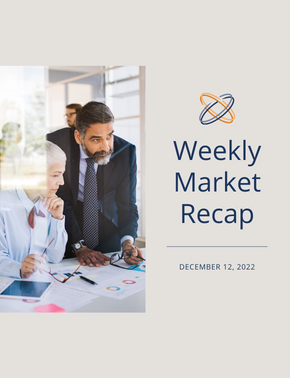Week in Review
Equity Markets:
The S&P 500 snapped a two-week winning streak last week, ending the week down 3.4%. The majority of the loss occurred on Friday. The drawdown was a reaction to mixed inflation data and concerns that it could impact monetary policy. The market rallied nearly 12% off the October lows and gained steam in recent weeks on the heels of a potential policy pivot by the Fed.
Third quarter earnings are essentially complete, and the S&P 500 recorded the slowest earnings growth rate since the pandemic. Quarterly earnings growth came in at 2.4%. 70% of companies beat earnings estimates, below the five-year average of 77%, according to FactSet.
Fixed Income Markets:
The 10-year treasury yield ended the week at 3.59%. Yields have seen a swift move down since mid-October. The 10-year’s current peak yield, 4.33%, occurred on October 20th. That is a 17% drop in yield in less than two months.
The yield curve remains severely inverted. The current 2’s/10’s inversion is more than 0.75%. The current inversion remains at the deepest territory in two decades. Recently, the inversion has “waterfalled” down the yield curve. The 30-day bill rate and 10-year bond rate are inverted. The 30-day rate is above 3.7% and the inversion sits at ~0.1%. This part of the yield curve is heavily followed by academics due to the consistency in recessionary predictive power. The financial media focuses on the 2’s/10’s because it historically inverts more quickly than the 30-day.
Economic:
The Producer Price Index released Friday was the headline economic report for the week. The report showed that inflation is at a minimum cooling but remains prevalent. Economists surveyed by Dow Jones expected the index to rise 0.2% in November. The actual number came in slightly higher at 0.3% and 7.4% from a year ago. The preliminary University of Michigan Consumer Sentiment Index improved from last month’s 56.8 to 59.1. This index has continued to climb from the all-time low of 50 recorded in June of this year.
Looking Ahead
Equity Markets:
As we move into Q4 earnings season, analysts expect earnings declines of ~2.5% according to data collected by FactSet. At the end of September, analysts were expecting earnings growth of 3.7%. It appears analysts anticipate the effects of the rate hikes to begin impacting corporations. We have noted previously that monetary policy takes time, historically six to nine months, before impacts are noticed.
The PPI report put doubts back into the market. The Fed’s messaging helped push the market higher and moves with a foundation on sentiment can be fragile until the structural weakness improves. The kind of market movement we have experienced since the October lows is likely to persist to varying degrees. Long-term investors should remain cognizant that we do not have the all-clear, but don’t forget what has already occurred in 2022. The market saw a trough of nearly 28%, which likely priced in a mild recession. The ultimate low may or may not be in yet. In our opinion, unless we see a more material weakness in the overall economy, which currently doesn’t appear to be there, the drawdown should remain close to the average recessionary drawdown of ~30%. For this reason, investors should not let the short-term noise allow them to waver from their long-term objectives.
Fixed Income Markets:
The headline event this week is the FOMC policy meeting, which concludes with Chairman Powell’s press conference at 1:00 pm on Wednesday. The Market has priced in a high probability of the Fed reducing their rate increase to 50 basis points, following four consecutive 75 basis point hikes. Following the recent rhetoric of slowing the pace of hikes from Fed officials, including Chairman Powell, we believe the Fed will follow through with a lower hike. Since Chairman Ben Bernanke, the Fed has utilized a highly transparent process and hoped to smooth expectations. If Jerome Powell were to throw a curveball, we expect the equity and fixed-income markets to react negatively.
Economic:
This week has the potential for many headlines and market-moving outcomes. On Tuesday, the same day the FOMC meeting begins, November’s CPI report will be released. A timely look into retail sales just before the holidays should provide some insight into one of the biggest spending times of the year.
Following the FOMC policy decision, a peek into the health of the economy is on deck with preliminary readings on the S&P Global Manufacturing & Services PMI. Regional manufacturing reports out of Philadelphia & New York will be released as well.
Important Disclosures:
Investment Advisory Services offered through Krilogy®, an SEC Registered Investment Advisor. Please review all prospectuses and Krilogy’s Form ADV 2A carefully prior to investing. This is neither an offer to sell nor a solicitation of an offer to buy the securities described herein. An offering is made only by a prospectus to individuals who meet minimum suitability requirements.
All expressions of opinion are subject to change. This information is distributed for educational purposes only, and it is not to be construed as an offer, solicitation, recommendation, or endorsement of any particular security, products, or services. Diversification does not eliminate the risk of market loss. Investments involve risk and unless otherwise stated, are not guaranteed. Investors should understand the risks involved of owning investments, including interest rate risk, credit risk and market risk. Investment risks include loss of principal and fluctuating value. There is no guarantee an investing strategy will be successful. Past performance is not a guarantee of future results. Indices are not available for direct investment; therefore, their performance does not reflect the expenses associated with the management of an actual portfolio. The S&P data is provided by Standard & Poor’s Index Services Group.
Services and products offered through Krilogy® are not insured and may lose value. Be sure to first consult with a qualified financial advisor and/or tax professional before implementing any strategy discussed herein.














